

Today, we’ll explore aviation in the last round of regular series theatrical cartoons – well past the Golden Age, so we’ll refer to it as the Silver Age – though perhaps bronze would be more appropriate, given the frequent dip in quality. Still, there are a few smiles to be had, and the decade climaxes with a certain degree of nostalgia, harkening back to the days of the classic biplane, and WWI.
 Bartholomew Versus the Wheel (Warner, 2/29/64 – Robert McKimson, dir.) – This arguably marks the strangest film Robert McKimson ever directed – and clearly the most unexplained. It has the feeling of being adapted from a children’s book – giving the film more of the vibe of a production from UPA or Rembrandt Films rather than any resemblance to Warner. Yet, its story material appears to have been developed in house. Why? There was no competition from UPA, who had dropped out of the theatrical business. Rembrandt may have seemed a more likely threat, despite its product receiving only limited distribution here, due to its Oscar win of a few years back for “Munro”, which also used child-like drawings. Paramount (probably unbeknownst to the Warner staff) was also on the verge of delving into a childlike style of visual, and would release the following year “The Story of George Washington”, based on a comic strip, “Jacky’s Whacky World”. Was this strip, or the influence of “Munro”, the common denominator that would cause two studios to make the same move in such a short time? Or were there other influences to make the choice of material more coincidental? Certainly, the continuing popularity of Dr. Seuss’s children’s stories would not have been forgotten to a studio who had worked with Seuss on the ground floor twenty or so years earlier, so a juvenile story might have seemed an exotic idea for a one-shot. And most important of all, stablemate Chuck Jones had been temporarily thriving on odd experimentation, with Oscar contentions for “Nelly’s Folly”, “High Note”, and the ultra-strange “Now Hear This” – and would soon carry on the tradition at MGM with “The Dot and the Line”. Jones was being given the heave-ho by the Warner executives for his authorship of the rival UPA production, “Gay Purr-ee”, leaving the studio without a creator for exotic one-shot contenders. So perhaps this project was simply dropped into McKimson’s lap by default, as the only likely successor to the throne for such fare. Or, perhaps, McKimson came up with it on his own, as a belated effort to vent professional jealousy – a literal expression of “Keeping up with the Jones.” Whatever the reason, the result seems far from satisfying, lacking the zing, wit, or off-the-wall gags of a Jones product, the satirical edginess of Deitch’s production, or the general goofiness of the Paramount product that was to follow. The cartoon appears to have been targeted for a younger audience than Warner’s usual demographics, essentially leaving the adult viewers behind for six minutes of humdrum filler – something that none of the rival products were ever guilty of. Despite some skillful background work in creating the appearance of childhood watercolor, the film ranks far below McKimson standards, and cannot by any stretch be classified as his best work. He was not the right man at the right time.
Bartholomew Versus the Wheel (Warner, 2/29/64 – Robert McKimson, dir.) – This arguably marks the strangest film Robert McKimson ever directed – and clearly the most unexplained. It has the feeling of being adapted from a children’s book – giving the film more of the vibe of a production from UPA or Rembrandt Films rather than any resemblance to Warner. Yet, its story material appears to have been developed in house. Why? There was no competition from UPA, who had dropped out of the theatrical business. Rembrandt may have seemed a more likely threat, despite its product receiving only limited distribution here, due to its Oscar win of a few years back for “Munro”, which also used child-like drawings. Paramount (probably unbeknownst to the Warner staff) was also on the verge of delving into a childlike style of visual, and would release the following year “The Story of George Washington”, based on a comic strip, “Jacky’s Whacky World”. Was this strip, or the influence of “Munro”, the common denominator that would cause two studios to make the same move in such a short time? Or were there other influences to make the choice of material more coincidental? Certainly, the continuing popularity of Dr. Seuss’s children’s stories would not have been forgotten to a studio who had worked with Seuss on the ground floor twenty or so years earlier, so a juvenile story might have seemed an exotic idea for a one-shot. And most important of all, stablemate Chuck Jones had been temporarily thriving on odd experimentation, with Oscar contentions for “Nelly’s Folly”, “High Note”, and the ultra-strange “Now Hear This” – and would soon carry on the tradition at MGM with “The Dot and the Line”. Jones was being given the heave-ho by the Warner executives for his authorship of the rival UPA production, “Gay Purr-ee”, leaving the studio without a creator for exotic one-shot contenders. So perhaps this project was simply dropped into McKimson’s lap by default, as the only likely successor to the throne for such fare. Or, perhaps, McKimson came up with it on his own, as a belated effort to vent professional jealousy – a literal expression of “Keeping up with the Jones.” Whatever the reason, the result seems far from satisfying, lacking the zing, wit, or off-the-wall gags of a Jones product, the satirical edginess of Deitch’s production, or the general goofiness of the Paramount product that was to follow. The cartoon appears to have been targeted for a younger audience than Warner’s usual demographics, essentially leaving the adult viewers behind for six minutes of humdrum filler – something that none of the rival products were ever guilty of. Despite some skillful background work in creating the appearance of childhood watercolor, the film ranks far below McKimson standards, and cannot by any stretch be classified as his best work. He was not the right man at the right time.
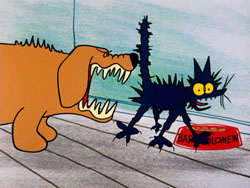 The oddball storyline follows the growth from puppy to doghood of a mutt known as Bartholomew, depicted in exceedingly rounded and simplified style, with “frying pan” eyes similar to early designs for Barney Rubble. The dog experiences a normal puppyhood (that is, pushed around by a cat), until one day “something bad” happens to him. A kid on a scooter runs over his tail, bending it. The dog takes off after the scooter, and rips off the wheel, burying it in the back yard. From that day forward, Bartholomew wages war on any wheeled contrivance, bringing home larger prizes as he grows to maturity. Bicycle wheels, auto wheels (sometimes with the car still attached), and even truck wheels (though careful to avoid stealing them from the dog catcher’s wagon). But there’s one type of wheel he’s never brought home – because they’re hard to catch. That is the huge tire off a commercial airliner. One day, the opportunity arises for Bartholomew to tunnel under the fence at the local airport, and he sets off after the tire of a plane just departing from the runway. He sinks his teeth into it, but suddenly realizes it’s a case of who has who, as the wheel lifts Bartholomew off the ground, and swallows him into the wheel well of the plane’s belly.
The oddball storyline follows the growth from puppy to doghood of a mutt known as Bartholomew, depicted in exceedingly rounded and simplified style, with “frying pan” eyes similar to early designs for Barney Rubble. The dog experiences a normal puppyhood (that is, pushed around by a cat), until one day “something bad” happens to him. A kid on a scooter runs over his tail, bending it. The dog takes off after the scooter, and rips off the wheel, burying it in the back yard. From that day forward, Bartholomew wages war on any wheeled contrivance, bringing home larger prizes as he grows to maturity. Bicycle wheels, auto wheels (sometimes with the car still attached), and even truck wheels (though careful to avoid stealing them from the dog catcher’s wagon). But there’s one type of wheel he’s never brought home – because they’re hard to catch. That is the huge tire off a commercial airliner. One day, the opportunity arises for Bartholomew to tunnel under the fence at the local airport, and he sets off after the tire of a plane just departing from the runway. He sinks his teeth into it, but suddenly realizes it’s a case of who has who, as the wheel lifts Bartholomew off the ground, and swallows him into the wheel well of the plane’s belly.
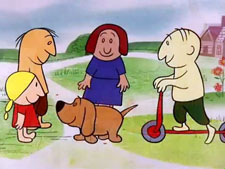 Bartholomew finds himself upon arrival in a strange land. The exact location is never disclosed, but the appearance of turbaned men, veiled women, elephants and camels, suggests a locale either in the Arabic nations or India. The Indian influence may be stronger, as humans avoid him, either as untouchable or perhaps sacred (as a local dog wears the distinction of a turban, and snubs him too). More distressing than the lack of attention is that there is not a wheel in sight to chase, as everyone walks or rides elephants or camels. Bartholomew sulks for a time, then has a light bulb light in his brain, as an idea develops. A wheel brought him here. Maybe it can also get him out and back home. Fortunately for Bartholomew, another plane is about to take off at the airport, and happens to be the return flight to his homeland. Another tire chase, and Bartholomew secures his passage back home. There, the townspeople, who have been searching for him, welcome him with a celebration parade. And Bartholomew is no longer mad at wheels, since one finally did him a good deed, and affectionately licks the tires of the townsfolk as a sign of peace. Bart instead turns his aggression to a more natural target – the cat who bullied him through puppyhood, who literally disintegrates at the sound of Bart’s angry growls behind him, as Bart grins to the camera in the final shot.
Bartholomew finds himself upon arrival in a strange land. The exact location is never disclosed, but the appearance of turbaned men, veiled women, elephants and camels, suggests a locale either in the Arabic nations or India. The Indian influence may be stronger, as humans avoid him, either as untouchable or perhaps sacred (as a local dog wears the distinction of a turban, and snubs him too). More distressing than the lack of attention is that there is not a wheel in sight to chase, as everyone walks or rides elephants or camels. Bartholomew sulks for a time, then has a light bulb light in his brain, as an idea develops. A wheel brought him here. Maybe it can also get him out and back home. Fortunately for Bartholomew, another plane is about to take off at the airport, and happens to be the return flight to his homeland. Another tire chase, and Bartholomew secures his passage back home. There, the townspeople, who have been searching for him, welcome him with a celebration parade. And Bartholomew is no longer mad at wheels, since one finally did him a good deed, and affectionately licks the tires of the townsfolk as a sign of peace. Bart instead turns his aggression to a more natural target – the cat who bullied him through puppyhood, who literally disintegrates at the sound of Bart’s angry growls behind him, as Bart grins to the camera in the final shot.
A final note on this film. Why does Bartholomew look so close in design to Spot from the Eric Hill children’s book series, minus the spots? Who “borrowed” this time?
Chilly Willy receives more than his fair share of encounters with aircraft during this period – at least five in all – which we’ll discuss as a group, instead of spreading them out throughout this article.
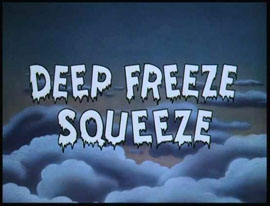 The earliest two, of course, are the best. Deep Freeze Squeeze (Lantz/Universal, Chilly Willy, 3/1/64 – Sid Marcus, dir.), has been previously reviewed in one of my earliest articles, “Unhealthy Appetites”. It is Sid’s nod to early Woody Woodpecker cartoons and to the refinement of their ideas that culminated in Tex Avery’s “What’s Buzzin’, Buzzard?”, where friend becomes foe in the face of starvation, and your neighbor might be your next meal. The premise for setting up the situation relies upon aircraft as its central plot point. The concept of the airlift of needed supplies had been in motion since WWII, and was part of popular culture of the day, with active ad campaigns for CARE packages to fly needed necessitates to remote foreign lands. It was thus fitting for the times that Marcus would place Chilly and Smedly on the receiving end of one of these cargo routes, stationed at a remotte base in the Antarctic. Their mess kitchen is bare, and the supply plane is two days late – a problem, where the days last six months. Cobwebs have grown between the boys as they wait resolutely at their dinner table for the hum of an aircraft motor, and Smedly’s tummy is really barking, to the point he has to command it, “Down, boy, down.” Finally an engine is heard. The two race outside frantically, waving and (in Smedly’s case) shouting to get the plane’s attention. But the plane seems intent on making no landing, presumably because the ice is too treacherous. Instead, it keeps making pass after pass over the base, until Smedly draws an X on the ice, and instructs “Drop it right on this spot”. The crew above complies – but hooks no parachute to the huge crate. The impact of the fall cracks clear through the ice, depositing both crate and our heroes into the icy water, while the plane resolutely soars away, presuming its mission accomplished. All that is recovered is one can of beans – mislabeled, as it in fact contains only a single bean. After a fierce competition between our heroes over who gets the can, its meager contents are devoured by a mouse (a lifted gag from Warner Bros.’ “Along Came Daffy”). Chilly loses all control – and sanity – begins devouring the plates on the table, then eyes Smedly with a face depicting unbelievable angst, as he visualizes the dog as an oversize hot dog. Mayhem ensues as Chilly tries every means to place Smedly on his menu as specialty of the day, while Smedly manages to get through a radio dispatch to send more food. Just as Smedly is simmering in a cooking pot, a second plane is heard. The frantic running and calls to the plane are repeated, and another X is drawn for the drop. This time, the weight of the crate will be no concern – as the ice is broken before the crate even reaches the ground, by a huge whale, who swallows the entire box, then disappears below the ice. Now it is Smedly who cracks, and Chilly looks just like a barbecued chicken wearing a snow cap. “Here, chick, chick, chick”, beckons Smedly while carrying a meat cleaver – and the pursuit is carried on in reverse for the iris out.
The earliest two, of course, are the best. Deep Freeze Squeeze (Lantz/Universal, Chilly Willy, 3/1/64 – Sid Marcus, dir.), has been previously reviewed in one of my earliest articles, “Unhealthy Appetites”. It is Sid’s nod to early Woody Woodpecker cartoons and to the refinement of their ideas that culminated in Tex Avery’s “What’s Buzzin’, Buzzard?”, where friend becomes foe in the face of starvation, and your neighbor might be your next meal. The premise for setting up the situation relies upon aircraft as its central plot point. The concept of the airlift of needed supplies had been in motion since WWII, and was part of popular culture of the day, with active ad campaigns for CARE packages to fly needed necessitates to remote foreign lands. It was thus fitting for the times that Marcus would place Chilly and Smedly on the receiving end of one of these cargo routes, stationed at a remotte base in the Antarctic. Their mess kitchen is bare, and the supply plane is two days late – a problem, where the days last six months. Cobwebs have grown between the boys as they wait resolutely at their dinner table for the hum of an aircraft motor, and Smedly’s tummy is really barking, to the point he has to command it, “Down, boy, down.” Finally an engine is heard. The two race outside frantically, waving and (in Smedly’s case) shouting to get the plane’s attention. But the plane seems intent on making no landing, presumably because the ice is too treacherous. Instead, it keeps making pass after pass over the base, until Smedly draws an X on the ice, and instructs “Drop it right on this spot”. The crew above complies – but hooks no parachute to the huge crate. The impact of the fall cracks clear through the ice, depositing both crate and our heroes into the icy water, while the plane resolutely soars away, presuming its mission accomplished. All that is recovered is one can of beans – mislabeled, as it in fact contains only a single bean. After a fierce competition between our heroes over who gets the can, its meager contents are devoured by a mouse (a lifted gag from Warner Bros.’ “Along Came Daffy”). Chilly loses all control – and sanity – begins devouring the plates on the table, then eyes Smedly with a face depicting unbelievable angst, as he visualizes the dog as an oversize hot dog. Mayhem ensues as Chilly tries every means to place Smedly on his menu as specialty of the day, while Smedly manages to get through a radio dispatch to send more food. Just as Smedly is simmering in a cooking pot, a second plane is heard. The frantic running and calls to the plane are repeated, and another X is drawn for the drop. This time, the weight of the crate will be no concern – as the ice is broken before the crate even reaches the ground, by a huge whale, who swallows the entire box, then disappears below the ice. Now it is Smedly who cracks, and Chilly looks just like a barbecued chicken wearing a snow cap. “Here, chick, chick, chick”, beckons Smedly while carrying a meat cleaver – and the pursuit is carried on in reverse for the iris out.
NOTE: None of these Chilly Willy cartoons is available for embed. At last, not that we know of.
 Fractured Friendship (Lantz/Univeral, 3/1/65 – Sid Marcus, dir.) – Smedly is sick of freezing in Chilly’s polar climate, and determines to set off for tropic climes. However, this means Chilly can’t tag along (though this has never stopped him before), as Smedly claims he would “melt” in the tropics. (So explain “Robinson Gruesome”, why don’cha?) Chilly thus decides to “help” Smedly on his way, with not-so-secret intention of fouling up Smedly’s plans to keep him icebound.
Fractured Friendship (Lantz/Univeral, 3/1/65 – Sid Marcus, dir.) – Smedly is sick of freezing in Chilly’s polar climate, and determines to set off for tropic climes. However, this means Chilly can’t tag along (though this has never stopped him before), as Smedly claims he would “melt” in the tropics. (So explain “Robinson Gruesome”, why don’cha?) Chilly thus decides to “help” Smedly on his way, with not-so-secret intention of fouling up Smedly’s plans to keep him icebound.
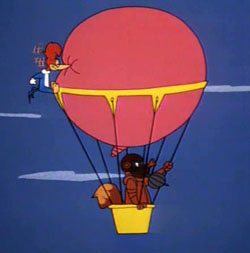 Some of Smedly’s methods of travel don’t seem to need much help from Chilly to fail. Smedly fastens a pusher prop and motor onto his back by means of tightening a waist belt, then sets the engine in motion. He only succeeds in being driven forward a few feet, to crash face-first into an ice wall. Another larger homemade machine has the dog with a huge propeller hat and riding a unicycle. Contact only results in the propeller standing still, while Smedley and the unicycle are corkscrewed into the ground. Chilly comes up with a flight idea of his own, fastening several live birds to each of Smedly’s arms by belts. The birds take off with Smedly successfully, but Chilly waves goodbye below, holding in one hand an upside-down box of bird seed, whose contents scatter all over the ground. The birds spy the tasty treat, darting downwards for their lunchtime meal, dashing their master deep into the snow. Smedly even tries a balloon – only to have the bag punctured, as Chilly calls upon the cameo assistance of Woody Woodpecker, who just happens to have found a tree to roost in in the Antarctic.
Some of Smedly’s methods of travel don’t seem to need much help from Chilly to fail. Smedly fastens a pusher prop and motor onto his back by means of tightening a waist belt, then sets the engine in motion. He only succeeds in being driven forward a few feet, to crash face-first into an ice wall. Another larger homemade machine has the dog with a huge propeller hat and riding a unicycle. Contact only results in the propeller standing still, while Smedley and the unicycle are corkscrewed into the ground. Chilly comes up with a flight idea of his own, fastening several live birds to each of Smedly’s arms by belts. The birds take off with Smedly successfully, but Chilly waves goodbye below, holding in one hand an upside-down box of bird seed, whose contents scatter all over the ground. The birds spy the tasty treat, darting downwards for their lunchtime meal, dashing their master deep into the snow. Smedly even tries a balloon – only to have the bag punctured, as Chilly calls upon the cameo assistance of Woody Woodpecker, who just happens to have found a tree to roost in in the Antarctic.
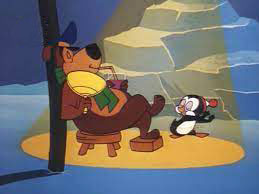 By the end of the film, Smedly’s last idea for transportation has fizzled again, and Chilly greets him with a hand-painted sign reading “Welcome home”. Smedly relents to try Chilly’s idea of paradise – a bask under a heat lamp, in a hammock strung from a fake palm tree, while Chilly performs a hula in a grass skirt. Unfortunately, the heat lamp melts a hole in the ice below them, plunging the two into icy water. “It didn’t work”, Smedly observes for the umpteeth time, but adds the coda, “but we’re together”, as Chilly gives Smedly an affectionate hug for the iris out.
By the end of the film, Smedly’s last idea for transportation has fizzled again, and Chilly greets him with a hand-painted sign reading “Welcome home”. Smedly relents to try Chilly’s idea of paradise – a bask under a heat lamp, in a hammock strung from a fake palm tree, while Chilly performs a hula in a grass skirt. Unfortunately, the heat lamp melts a hole in the ice below them, plunging the two into icy water. “It didn’t work”, Smedly observes for the umpteeth time, but adds the coda, “but we’re together”, as Chilly gives Smedly an affectionate hug for the iris out.
The remaining three titles are representative samples which date from the period when Paul J. Smith became Lantz’s sole remaining director, saddled with the task of churning out three series at once (Woody Woodpecker, Chilly Willy, and the Beary Family). The task might have been daunting to the best of directors – and Smith certainly was not the best of directors, by now being well past his prime powers of creativity. The results generally run from passable to inept, with some episodes feeling boring, or decidedly out-of-character, or both. Add to this a new dependency of the writer(s?) upon giving Chilly a speaking voice instead of playing scripts in pantomime, and much of the original charm of Tex Avery’s personality creation vanishes quickly.
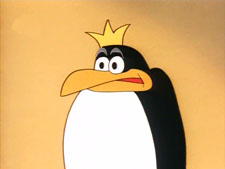 South Pole Pals (Lantz/Universal, 5/1/66) – Mrs. Moneybags, founder of the Moneybags Foundation Zoological Society, insists that the foundation’s museum include a specimen of an emperor penguin, or she will make no further donations. Abernathy, curator of the collection, informs her the last eight explorers they sent out never even returned. Moneybags insists that he go himself, if necessary. Abernathy has a better idea, and enlists the help or Smedly, who is dusting off stuffed trophy heads in the collection. “Smedly, you’ve been working like a dog”, says Abernathy. “Oh, I am a dog, sir”, responds the able servant. Abernathy claims he intends to reward Smedly, by sending him South for the winter. Smedly envisions himself sunbathing on a hammock between two palm trees, and consents. He enjoys a comfortable ride in a passenger airline, then is told by a stewardess, “This is where you get off”. He exits the plane onto the wing, and jumps with a parachute. He performs a variant on the “count to ten too slow” gag from “Goofy’s Glider”, crashing through a surface layer of ice and landing on the ocean floor below before he has reached the number ten, then pulling the cord. When he climbs back out the hole he has made, he sees a sign nearby reading “South Pole” (where actually, there would be no ice cap at all, but solid land beneath the frozen surface – but who pays attention to details?) As Smedly realizes he has been duped as to reaching any warm tropical climes, he begins mumbling, and holds up a sign full of cartoon swear word symbols to translate what he is saying about his boss.
South Pole Pals (Lantz/Universal, 5/1/66) – Mrs. Moneybags, founder of the Moneybags Foundation Zoological Society, insists that the foundation’s museum include a specimen of an emperor penguin, or she will make no further donations. Abernathy, curator of the collection, informs her the last eight explorers they sent out never even returned. Moneybags insists that he go himself, if necessary. Abernathy has a better idea, and enlists the help or Smedly, who is dusting off stuffed trophy heads in the collection. “Smedly, you’ve been working like a dog”, says Abernathy. “Oh, I am a dog, sir”, responds the able servant. Abernathy claims he intends to reward Smedly, by sending him South for the winter. Smedly envisions himself sunbathing on a hammock between two palm trees, and consents. He enjoys a comfortable ride in a passenger airline, then is told by a stewardess, “This is where you get off”. He exits the plane onto the wing, and jumps with a parachute. He performs a variant on the “count to ten too slow” gag from “Goofy’s Glider”, crashing through a surface layer of ice and landing on the ocean floor below before he has reached the number ten, then pulling the cord. When he climbs back out the hole he has made, he sees a sign nearby reading “South Pole” (where actually, there would be no ice cap at all, but solid land beneath the frozen surface – but who pays attention to details?) As Smedly realizes he has been duped as to reaching any warm tropical climes, he begins mumbling, and holds up a sign full of cartoon swear word symbols to translate what he is saying about his boss.
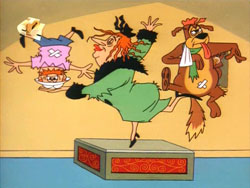 The body of the cartoon is a rather uninspired “mistaken identity” plot, as Chilly, who passes himself off in the belief he may be an emperor penguin, is in fact protected by a real crown-bearing emperor at least five times Chilly’s size, and twice the size of Smedly. Smedly repeatedly gets blindsided and belted, and is amazed at how strong that “little fella” must be. When the true existence of the bigger bodyguard is finally revealed to Smedly, Smedly explains his mission to bring back an emperor penguin. “I’m an emperor penguin”, boasts the true royalty, and, in a complete falter in plot continuity, the penguin confides that he’s always wanted to see New York. (How did he know the Foundation is based there, considering Smedly not only hasn’t yet mentioned the foundation’s name, nor its location – nor has its location even been disclosed yet to the audience?) The trio fly back aboard another plane. (Where did they make connections, given that Smedly had to parachute on the way in?) Back at the foundation. Mrs. Moneybags (who, incidentally, turns out to be the mother of spoiled brat Reginald, having first appeared in Woody Woodpecker’s 1960’s “The Bird Who Came To Dinner”) is called to see Smedly’s capture. Moneybags announces that the penguin shall be stuffed and placed on a pedestal. This wasn’t in the deal as far as the Emperor is concerned. “Ain’t nobody gonna stuff me!”, he proclaims, and advances on Moneybags, Abernathy, and Smedly. The three Foundation members soon find themselves knocked unconscious, and placed together in an artistic pose atop the pedestal. Chilly and the Emperor return home via another plane, this time hitching a ride outside aboard the plane’s tail (in the same manner as the Western Airlines bird). “Me emperor penguin too”, boasts Chilly. The Emperor agrees, by letting Chilly wear the crown for the return trip.
The body of the cartoon is a rather uninspired “mistaken identity” plot, as Chilly, who passes himself off in the belief he may be an emperor penguin, is in fact protected by a real crown-bearing emperor at least five times Chilly’s size, and twice the size of Smedly. Smedly repeatedly gets blindsided and belted, and is amazed at how strong that “little fella” must be. When the true existence of the bigger bodyguard is finally revealed to Smedly, Smedly explains his mission to bring back an emperor penguin. “I’m an emperor penguin”, boasts the true royalty, and, in a complete falter in plot continuity, the penguin confides that he’s always wanted to see New York. (How did he know the Foundation is based there, considering Smedly not only hasn’t yet mentioned the foundation’s name, nor its location – nor has its location even been disclosed yet to the audience?) The trio fly back aboard another plane. (Where did they make connections, given that Smedly had to parachute on the way in?) Back at the foundation. Mrs. Moneybags (who, incidentally, turns out to be the mother of spoiled brat Reginald, having first appeared in Woody Woodpecker’s 1960’s “The Bird Who Came To Dinner”) is called to see Smedly’s capture. Moneybags announces that the penguin shall be stuffed and placed on a pedestal. This wasn’t in the deal as far as the Emperor is concerned. “Ain’t nobody gonna stuff me!”, he proclaims, and advances on Moneybags, Abernathy, and Smedly. The three Foundation members soon find themselves knocked unconscious, and placed together in an artistic pose atop the pedestal. Chilly and the Emperor return home via another plane, this time hitching a ride outside aboard the plane’s tail (in the same manner as the Western Airlines bird). “Me emperor penguin too”, boasts Chilly. The Emperor agrees, by letting Chilly wear the crown for the return trip.
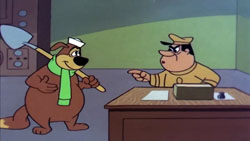 Hot Time on Ice (Lantz/Universal, 3/1/67), finds Smedly in an underground polar weather station hidden below the snow. The base’s food supply is running low, and Smedly is ordered to fly to a neighboring base for more supplies. His trip is a bumpy one that never gets off the ground, as his plane’s wheels find the ice runway of the camp perforated with holes like Swiss cheese – all because Chilly has taken up ice fishing, cutting holes everywhere with a jack hammer. Things really never get much “hotter” than this starting premise, the only action being split between a sequence where Smedley becomes wound up in the hose of the jack hammer, and Chilly sets the machine running, to cut a hole in the base’s roof and wreck the place inside; and an overstretched series of “contact” gags retreading old ground at turning the plane prop for the commanding officer, with the prop either getting stuck in place or falling out, followed by the standard trope of Chilly ripping off the plane’s skin by tying a rope to the tail. Even though the plane should come down, the writers simply surmise that the captain flies off to exit the film entirely, and Chilly and Smedley calmly spend the day ice fishing. Quite disappointing.
Hot Time on Ice (Lantz/Universal, 3/1/67), finds Smedly in an underground polar weather station hidden below the snow. The base’s food supply is running low, and Smedly is ordered to fly to a neighboring base for more supplies. His trip is a bumpy one that never gets off the ground, as his plane’s wheels find the ice runway of the camp perforated with holes like Swiss cheese – all because Chilly has taken up ice fishing, cutting holes everywhere with a jack hammer. Things really never get much “hotter” than this starting premise, the only action being split between a sequence where Smedley becomes wound up in the hose of the jack hammer, and Chilly sets the machine running, to cut a hole in the base’s roof and wreck the place inside; and an overstretched series of “contact” gags retreading old ground at turning the plane prop for the commanding officer, with the prop either getting stuck in place or falling out, followed by the standard trope of Chilly ripping off the plane’s skin by tying a rope to the tail. Even though the plane should come down, the writers simply surmise that the captain flies off to exit the film entirely, and Chilly and Smedley calmly spend the day ice fishing. Quite disappointing.
 Project Reject (Lantz/Universal, 3/5/69), places Smedley in a newly-constructed military base, with a primary mission of scanning the skies for intruding aircraft and UFO’s. They construct next door to Chilly’s igloo overnight. Admiral Addlepate orders Smedly to check out an “unidentified object at 2:00″. “We got lots of time, sir – It’s only 1:15″, responds Smedly. (This gag was pretty funny on its first pass – but Smith repeats it with only minor variation three times during the film, making its repetitions seem moronic, and falling flat as a pancake.) Smedly fires up a fast jet outside, whose exhaust is pointing directly at Chilly’s igloo. Chilly’s ice dome is melted in a hurry, leaving the penguin hopping mad and shouting incomprehensible swear words. The whole process is repeated twice, melting away a second igloo. Chilly finally pounds on the installation’s door, challenging them, “You go. Me here first”. Smedly receives a snowball in the face, and concludes he’ll have to write Chilly up as a troublemaker. The Admiral tries to impose a little discipline over his unable assistant, pulling rank on Smedly. “See these scrambled eggs?”, he says, pointing to decorations of honor on his hat, colloquially referred to by such term in the military. Smedly believes he is being offered lunch, and eats them! On Smedly’s next takeoff, Chilly ties a rope to the plane’s tail, repeating the old gag of pulling off the plane’s skin. Smedly resorts to an ejector seat, just as the plane tilts and begins to fly upside down, Smedly is rocketed out of the cockpit – straight into and through the ice of a frozen lake below. Emerging from the water, Smedly remarks, “I’m gonna see that the Ajax ejection seat company hears about this.”
Project Reject (Lantz/Universal, 3/5/69), places Smedley in a newly-constructed military base, with a primary mission of scanning the skies for intruding aircraft and UFO’s. They construct next door to Chilly’s igloo overnight. Admiral Addlepate orders Smedly to check out an “unidentified object at 2:00″. “We got lots of time, sir – It’s only 1:15″, responds Smedly. (This gag was pretty funny on its first pass – but Smith repeats it with only minor variation three times during the film, making its repetitions seem moronic, and falling flat as a pancake.) Smedly fires up a fast jet outside, whose exhaust is pointing directly at Chilly’s igloo. Chilly’s ice dome is melted in a hurry, leaving the penguin hopping mad and shouting incomprehensible swear words. The whole process is repeated twice, melting away a second igloo. Chilly finally pounds on the installation’s door, challenging them, “You go. Me here first”. Smedly receives a snowball in the face, and concludes he’ll have to write Chilly up as a troublemaker. The Admiral tries to impose a little discipline over his unable assistant, pulling rank on Smedly. “See these scrambled eggs?”, he says, pointing to decorations of honor on his hat, colloquially referred to by such term in the military. Smedly believes he is being offered lunch, and eats them! On Smedly’s next takeoff, Chilly ties a rope to the plane’s tail, repeating the old gag of pulling off the plane’s skin. Smedly resorts to an ejector seat, just as the plane tilts and begins to fly upside down, Smedly is rocketed out of the cockpit – straight into and through the ice of a frozen lake below. Emerging from the water, Smedly remarks, “I’m gonna see that the Ajax ejection seat company hears about this.”
 Chilly decides to invent a few “Bogeys” of his own, by launching a radio-controlled toy plane. Manipulating the controls, he flies a complex zig-zag pattern over the radar tower, “Egad”, comments the Admiral, and orders Smedly outside to watch the skies for a UFO at 10, 11, 12, 1, 2, and 3 o’clock. Meanwhile, the Admiral decides to send up a seek-out-and-destroy Nike missile. Smedly just happens to be standing atop the hatchway doors of the bunker holding the missile, which open under him, setting him astride the weapon much like Slim Pickens in “Dr. Strangelove”. The missile fires, sending Smedly on a wild-goose chase after the toy plane. (The sequence receives better musical scoring than usual for a Lantz project of this time, the small combo doing its best to vigorously perform a medley of Sousa marches, which enhances the action much like similar uses in Popeye films.) Chilly sets the plane to perform barrel rolls, causing the missile to mimic the same maneuver for a dizzy Smedly. Some up and down bouncing of the plane causes Smedly’s mount to buck like a wild bronco. Finally, Chilly gets an evil idea, as he sprouts devil’s horns and states, “I dood it.” He sets the plane on a collision course with the front door of the military installation, with the missile following right behind. An explosion – and the Admiral’s headquarters are in tatters, as is the Admiral. Turning Smedly around, the Admiral begins vigorously kicking Smedly in the rear end, and pursues him with more kicks over the farthest hills, while Chilly returns to a peaceful evening’s sleep, and bids us good night.
Chilly decides to invent a few “Bogeys” of his own, by launching a radio-controlled toy plane. Manipulating the controls, he flies a complex zig-zag pattern over the radar tower, “Egad”, comments the Admiral, and orders Smedly outside to watch the skies for a UFO at 10, 11, 12, 1, 2, and 3 o’clock. Meanwhile, the Admiral decides to send up a seek-out-and-destroy Nike missile. Smedly just happens to be standing atop the hatchway doors of the bunker holding the missile, which open under him, setting him astride the weapon much like Slim Pickens in “Dr. Strangelove”. The missile fires, sending Smedly on a wild-goose chase after the toy plane. (The sequence receives better musical scoring than usual for a Lantz project of this time, the small combo doing its best to vigorously perform a medley of Sousa marches, which enhances the action much like similar uses in Popeye films.) Chilly sets the plane to perform barrel rolls, causing the missile to mimic the same maneuver for a dizzy Smedly. Some up and down bouncing of the plane causes Smedly’s mount to buck like a wild bronco. Finally, Chilly gets an evil idea, as he sprouts devil’s horns and states, “I dood it.” He sets the plane on a collision course with the front door of the military installation, with the missile following right behind. An explosion – and the Admiral’s headquarters are in tatters, as is the Admiral. Turning Smedly around, the Admiral begins vigorously kicking Smedly in the rear end, and pursues him with more kicks over the farthest hills, while Chilly returns to a peaceful evening’s sleep, and bids us good night.
 Just Plane Beep (DePatie-Freleng, Warner, Road Runner, 10/30/65 – Rudy Larriva, dir.) – After running face first into a cliffside while the Road Runner makes his usual lightning-fast disappearance down the road a-piece, Wile E. Coyote has a stray sheet of paper blow onto the end of his nose. It is an advertisement for a war surplus sale, with mail-in coupon. Wile E. posts an order, and receives a package tightly stuffed in his mailbox, which, when removed, expands to nearly crush him under its weight. The contents are the components for an old WWI biplane, complete with a blueprint of reassembly instructions. After substantial effort with hammer and wrench, a beat-up plane, with trails of bullet holes in its fabric and portions of wing covering missing, materializes. Wile E. outfits himself as an aviator, then faces the old standby problem of spinning the prop. Third try gets it spinning, with him still clinging to it, and when he lets go, he is shot into the air. He pulls a parachute ripcord, but the equipment, aged and faulty, merely rips off the straps attaching the chute to his back, letting him splat upon the pavement. Undaunted, he returns to his cockpit, and rolls off down the road. Attaining no altitude, he reads his instruction manual, telling him to pull back on the stick. He does, and it comes off in his hand. Another crash into the mountainside.
Just Plane Beep (DePatie-Freleng, Warner, Road Runner, 10/30/65 – Rudy Larriva, dir.) – After running face first into a cliffside while the Road Runner makes his usual lightning-fast disappearance down the road a-piece, Wile E. Coyote has a stray sheet of paper blow onto the end of his nose. It is an advertisement for a war surplus sale, with mail-in coupon. Wile E. posts an order, and receives a package tightly stuffed in his mailbox, which, when removed, expands to nearly crush him under its weight. The contents are the components for an old WWI biplane, complete with a blueprint of reassembly instructions. After substantial effort with hammer and wrench, a beat-up plane, with trails of bullet holes in its fabric and portions of wing covering missing, materializes. Wile E. outfits himself as an aviator, then faces the old standby problem of spinning the prop. Third try gets it spinning, with him still clinging to it, and when he lets go, he is shot into the air. He pulls a parachute ripcord, but the equipment, aged and faulty, merely rips off the straps attaching the chute to his back, letting him splat upon the pavement. Undaunted, he returns to his cockpit, and rolls off down the road. Attaining no altitude, he reads his instruction manual, telling him to pull back on the stick. He does, and it comes off in his hand. Another crash into the mountainside.
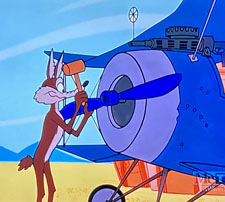 These plane parts are more durable than they look, and after another round of labor, the plane is reassembled, as good as old. Wile E. takes off from a high cliff, and swoops over the Road Runner below. He produces a timed hand bomb to drop over the side upon the bird, but fails to allow for the air stream along the side of the plane when he releases it. The bomb is swept back along the fuselage, and lodges in the rudder wire. Wile E. cautiously climbs out over the fuselage to pull loose the bomb from the tail – leaving the control stick unmanned. He frees the bomb, and tosses it past the tail, hoping this will end his troubles. He fails to notice that the plane has changed course into a nose dive, so that gravity pull brings the bomb right back to his hand. Two more attempts to toss the bomb away similarly fail – then CRASH!. Wile E. winds up just clear of the wreckage, flat on his back, with the bomb still in his hand. He gives it one more toss up, and it neatly falls directly upon his tummy for a KER-BOOM!
These plane parts are more durable than they look, and after another round of labor, the plane is reassembled, as good as old. Wile E. takes off from a high cliff, and swoops over the Road Runner below. He produces a timed hand bomb to drop over the side upon the bird, but fails to allow for the air stream along the side of the plane when he releases it. The bomb is swept back along the fuselage, and lodges in the rudder wire. Wile E. cautiously climbs out over the fuselage to pull loose the bomb from the tail – leaving the control stick unmanned. He frees the bomb, and tosses it past the tail, hoping this will end his troubles. He fails to notice that the plane has changed course into a nose dive, so that gravity pull brings the bomb right back to his hand. Two more attempts to toss the bomb away similarly fail – then CRASH!. Wile E. winds up just clear of the wreckage, flat on his back, with the bomb still in his hand. He gives it one more toss up, and it neatly falls directly upon his tummy for a KER-BOOM!
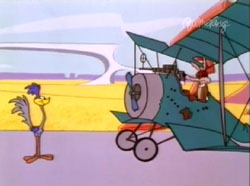 Another rebuild, and another descent upon the Road-Runner. Taxiing upon the pavement behind the bird, Wile E. fires up the machine guns – only to find they are no longer synchronous with the engine, and shoot the prop off. Repairing the prop, Wile E. becomes airborne again, but flies into some high-tension wires, slingshotting him back a few miles over the horizon. With another wreck to repair, Wile E. surveys the damage, setting his blueprint briefly upon the engine cowling. A stiff desert wind blows the blueprint to parts unknown. Wile E. puzzles what to do next, but figures he’s made repairs so often, he must be an old pro at it by now. He is next seen aloft again – only the plane is now holding itself together by a thread, dropping engine bolts every few seconds, and displaying a large gap in its panels under the cockpit. After a few seconds, Wile E. falls through the floor of the cockpit, and out the hole. A large bomb is loosely tethered below the aircraft, and its straps also come apart, jettisoning the bomb on the same descent path as the coyote. Wile E. creates a coyote-shaped crater from the force of his impact, then looks up to see the bomb approaching. All he can do is give the audience a final military salute, as the bomb enters the crater alongside him. The Road-Runner happily beep-beeps after the explosion, and the film ends.
Another rebuild, and another descent upon the Road-Runner. Taxiing upon the pavement behind the bird, Wile E. fires up the machine guns – only to find they are no longer synchronous with the engine, and shoot the prop off. Repairing the prop, Wile E. becomes airborne again, but flies into some high-tension wires, slingshotting him back a few miles over the horizon. With another wreck to repair, Wile E. surveys the damage, setting his blueprint briefly upon the engine cowling. A stiff desert wind blows the blueprint to parts unknown. Wile E. puzzles what to do next, but figures he’s made repairs so often, he must be an old pro at it by now. He is next seen aloft again – only the plane is now holding itself together by a thread, dropping engine bolts every few seconds, and displaying a large gap in its panels under the cockpit. After a few seconds, Wile E. falls through the floor of the cockpit, and out the hole. A large bomb is loosely tethered below the aircraft, and its straps also come apart, jettisoning the bomb on the same descent path as the coyote. Wile E. creates a coyote-shaped crater from the force of his impact, then looks up to see the bomb approaching. All he can do is give the audience a final military salute, as the bomb enters the crater alongside him. The Road-Runner happily beep-beeps after the explosion, and the film ends.
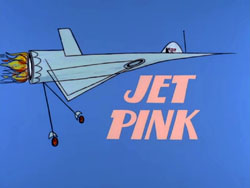 Jet Pink (DePatie-Freleng, UA, Pink Panther, 6/13/67 – Gerry Chiniquy, dir.), allows the panther to log his first few hours of flight time. Ever mindless of the places he wanders into, the panther maintains his usual cool as he strolls without hesitation onto the proving grounds of a restricted military base, where the X-13 experimental jet is undergoing tests (playing upon the “X–15″ designation of actual sound-barrier breaking aircraft of the day). The panther watches in awe as the prototype makes several passes by him in the sky above, then gracefully soars in for a perfect landing. Pink never attempts to meet or congratulate the pilot. Instead, he envisions an image of himself in a thought cloud above his head, wearing a crash helmet, with the inscription on his dream, “Famous Pilot.” Pink waits for his chance when everyone has left the field, then plays Looky-Lou, peering into the cockpit of the jet. Temptation is too great, and he hops into the cockpit seat to try it for size. He closes the cockpit dome, and gazes over the complex dashboard of gauges, switches, buttons, and computer readout screens. Just for fun, he picks a button at random to push. Wouldn’t you know it’s the ignition button. The plane roars to a fast takeoff, reaching the end of the runway at mach speed, then by itself veering upwards just short of collision with the hangar. Pink is pressed by the G-forces tightly into the back cushion of his seat, and his natural pink pulses out of his circulatory system, leaving him briefly white. The plane seeks to create its own flight path, and momentarily gets stuck in a repeating loop-de-loop. Pink still remains motionless – and very dizzy – inside. Suddenly, the plane breaks out of it, and Pink finds himself soaring straight up.
Jet Pink (DePatie-Freleng, UA, Pink Panther, 6/13/67 – Gerry Chiniquy, dir.), allows the panther to log his first few hours of flight time. Ever mindless of the places he wanders into, the panther maintains his usual cool as he strolls without hesitation onto the proving grounds of a restricted military base, where the X-13 experimental jet is undergoing tests (playing upon the “X–15″ designation of actual sound-barrier breaking aircraft of the day). The panther watches in awe as the prototype makes several passes by him in the sky above, then gracefully soars in for a perfect landing. Pink never attempts to meet or congratulate the pilot. Instead, he envisions an image of himself in a thought cloud above his head, wearing a crash helmet, with the inscription on his dream, “Famous Pilot.” Pink waits for his chance when everyone has left the field, then plays Looky-Lou, peering into the cockpit of the jet. Temptation is too great, and he hops into the cockpit seat to try it for size. He closes the cockpit dome, and gazes over the complex dashboard of gauges, switches, buttons, and computer readout screens. Just for fun, he picks a button at random to push. Wouldn’t you know it’s the ignition button. The plane roars to a fast takeoff, reaching the end of the runway at mach speed, then by itself veering upwards just short of collision with the hangar. Pink is pressed by the G-forces tightly into the back cushion of his seat, and his natural pink pulses out of his circulatory system, leaving him briefly white. The plane seeks to create its own flight path, and momentarily gets stuck in a repeating loop-de-loop. Pink still remains motionless – and very dizzy – inside. Suddenly, the plane breaks out of it, and Pink finds himself soaring straight up.
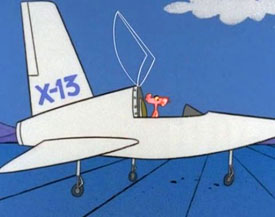 Essentially, the same setup is repeated previously used by the studio’s founder in Hare Lift for Bugs Bunny, as the plane climbs into space, leaving a vanishing and diminishing Earth, then performs a u-turn to settle into a power dive back toward the planet. The plane swoops into a pass through the heart of a busy city, buzzing pedestrians with its low flying, and chasing motorists through a mountain tunnel of a highway. Pink has had enough of being a passive passenger, and starts pushing every button and flicking every switch he can. A message begins to formulate in lights on a readout screen, spelling “Bombs Away.” A hatch opens under Pink’s seat, and the panther falls through. Despite the phenomenal speed of the plane, Pink’s determination to get back inside is nearly as phenomenal, and he spins both his arms like propellers to attempt to intercept and regain a seat in the plane. He follows the plane in a zig-zag path through the sky, but finds himself losing ground in the race to catch up. Or is it “finding ground”, as Pink looks down, and realizes that instead of flying, his feet have re-connected with terra firma between his toes, and he is back on the surface. With a gesture of disdain, Pink makes clear he wants nothing further to do with the aircraft, and resumes his leisurely gait from the beginning of the picture. But peace is not won so easily for the panther, as the sound of engines signals the plane is sneaking up behind him, and picks him up by its nose, sliding him back along the plane’s body so that he is left clinging to the tail. The panther’s own tail droops behind, leaving it in line with the jet exhaust flames from the engine. By the time the panther notices, several inches from the tip of his tail have been reduced to a loose column of ashes. As if not having the constitution to face saying goodbye to an old friend, Pink closes his eyes and turns his face away, then taps the end of his tail with a finger, letting the ashes fall as if the burnt-out remains of an old cigar butt.
Essentially, the same setup is repeated previously used by the studio’s founder in Hare Lift for Bugs Bunny, as the plane climbs into space, leaving a vanishing and diminishing Earth, then performs a u-turn to settle into a power dive back toward the planet. The plane swoops into a pass through the heart of a busy city, buzzing pedestrians with its low flying, and chasing motorists through a mountain tunnel of a highway. Pink has had enough of being a passive passenger, and starts pushing every button and flicking every switch he can. A message begins to formulate in lights on a readout screen, spelling “Bombs Away.” A hatch opens under Pink’s seat, and the panther falls through. Despite the phenomenal speed of the plane, Pink’s determination to get back inside is nearly as phenomenal, and he spins both his arms like propellers to attempt to intercept and regain a seat in the plane. He follows the plane in a zig-zag path through the sky, but finds himself losing ground in the race to catch up. Or is it “finding ground”, as Pink looks down, and realizes that instead of flying, his feet have re-connected with terra firma between his toes, and he is back on the surface. With a gesture of disdain, Pink makes clear he wants nothing further to do with the aircraft, and resumes his leisurely gait from the beginning of the picture. But peace is not won so easily for the panther, as the sound of engines signals the plane is sneaking up behind him, and picks him up by its nose, sliding him back along the plane’s body so that he is left clinging to the tail. The panther’s own tail droops behind, leaving it in line with the jet exhaust flames from the engine. By the time the panther notices, several inches from the tip of his tail have been reduced to a loose column of ashes. As if not having the constitution to face saying goodbye to an old friend, Pink closes his eyes and turns his face away, then taps the end of his tail with a finger, letting the ashes fall as if the burnt-out remains of an old cigar butt.
 Pink returns to the cockpit, and once more tries to take command of the aircraft, reading up on an instruction manual he has discovered among the plane’s contents. He again begins to press buttons and flick switches. The light display again begins to formulate words, but new ones – “Ejector Seat”. Pink reacts with a startled take, this not being what he was trying for. He quickly fastens his seat belt, and braces for the thrust about to come. The seat jettisons, and Pink finds an instruction label teling him to count to ten before pulling parachute cord. As did Goofy in 1940, Pink counts too slow, crashes first, then pulls the cord to cover himself with the now useless silk. A police whistle sounds from the grounds upon which he has landed. Facing Pink are two military MP’s. armed weith Billy clubs. Pink attempts a very slow and casual walk away. The MP’s advance, gaining speed. Pink shifts into a faster gear. So do the police. As the film fades out, both panther and cops are running at top speed, in pursuit over the horizon – and that’s all they wrote.
Pink returns to the cockpit, and once more tries to take command of the aircraft, reading up on an instruction manual he has discovered among the plane’s contents. He again begins to press buttons and flick switches. The light display again begins to formulate words, but new ones – “Ejector Seat”. Pink reacts with a startled take, this not being what he was trying for. He quickly fastens his seat belt, and braces for the thrust about to come. The seat jettisons, and Pink finds an instruction label teling him to count to ten before pulling parachute cord. As did Goofy in 1940, Pink counts too slow, crashes first, then pulls the cord to cover himself with the now useless silk. A police whistle sounds from the grounds upon which he has landed. Facing Pink are two military MP’s. armed weith Billy clubs. Pink attempts a very slow and casual walk away. The MP’s advance, gaining speed. Pink shifts into a faster gear. So do the police. As the film fades out, both panther and cops are running at top speed, in pursuit over the horizon – and that’s all they wrote.
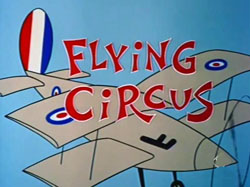 Flying Circus (Warner/Seven Arts, 9/14/68 – Alex Lovy, dir.) – By this time, the popularity of WWI throwbacks had been cemented with the tales of Snoopy vs. The Red Baron created by Charles Schulz in the “Peanuts” strip and specials – so it was fair game for other animators to try to play copycat. This effort is reasonably lively, and includes a few reasonably-well drawn shots of dogfight action. Bill Lava falls back on a few vintage WWI tunes, and (presumably in honor of voice artist Larry Storch’s recurring role in the series “F Troop”), punctuates his action riffs with occasional repetitions of the cavalry charge. The plot involves an Eddie Rickenbacker-type ace, complete with Spad !3 in appropriate markings, vs. a German ace with red biplane (not triplane, so as not to infringe upon any “Peanuts” scripts). After a credit sequence of aerial loops and barrel-rolls, the Spad plane comes in for a landing, and the handsome, teeth-glittering ace walks up to the first person he sees on the landing strip, slaps him on the back, and starts boasting about the dogfight he just had, and the sauerkraut he just shot down. The man he is talking to turns, displaying an iron cross medal on his chest. The ace spots others on the field, wearing spiked German helmets, and a red plane on the runway also bearing telltale cross insignia. “Wrong airfield, huh?”, the ace sheepishly inquires. Not only is he correct, but the pilot he was speaking to is the same one he just shot down. The Germans attempt to capture him, in inept fashion. One of the helmeted soldiers charges headfirst, missing the ace, and sticking his point directly into the Baron’s rear. Another attempts to fire a cannon, which the ace flips over in reverse. The soldier tries to cover the muzzle pointing at him with his hands – and gets a mitt full of cannonball which smashes him into a brick wall. The ace breaks off half his prop trying to restart his engine, bit the other half is enough to mow down the pursuing Baron and rip his pants off, exposing polka-dot shorts. “Crazy Sunday driver”, the Baron shouts.
Flying Circus (Warner/Seven Arts, 9/14/68 – Alex Lovy, dir.) – By this time, the popularity of WWI throwbacks had been cemented with the tales of Snoopy vs. The Red Baron created by Charles Schulz in the “Peanuts” strip and specials – so it was fair game for other animators to try to play copycat. This effort is reasonably lively, and includes a few reasonably-well drawn shots of dogfight action. Bill Lava falls back on a few vintage WWI tunes, and (presumably in honor of voice artist Larry Storch’s recurring role in the series “F Troop”), punctuates his action riffs with occasional repetitions of the cavalry charge. The plot involves an Eddie Rickenbacker-type ace, complete with Spad !3 in appropriate markings, vs. a German ace with red biplane (not triplane, so as not to infringe upon any “Peanuts” scripts). After a credit sequence of aerial loops and barrel-rolls, the Spad plane comes in for a landing, and the handsome, teeth-glittering ace walks up to the first person he sees on the landing strip, slaps him on the back, and starts boasting about the dogfight he just had, and the sauerkraut he just shot down. The man he is talking to turns, displaying an iron cross medal on his chest. The ace spots others on the field, wearing spiked German helmets, and a red plane on the runway also bearing telltale cross insignia. “Wrong airfield, huh?”, the ace sheepishly inquires. Not only is he correct, but the pilot he was speaking to is the same one he just shot down. The Germans attempt to capture him, in inept fashion. One of the helmeted soldiers charges headfirst, missing the ace, and sticking his point directly into the Baron’s rear. Another attempts to fire a cannon, which the ace flips over in reverse. The soldier tries to cover the muzzle pointing at him with his hands – and gets a mitt full of cannonball which smashes him into a brick wall. The ace breaks off half his prop trying to restart his engine, bit the other half is enough to mow down the pursuing Baron and rip his pants off, exposing polka-dot shorts. “Crazy Sunday driver”, the Baron shouts.
 The Baron takes off in pursuit of the escaping ace. A near-repeat of the Wile E. Coyote toss-the-bomb gag from “Just Plane Beep” appears, with the Baron repeatedly attempting to toss a bomb at the Spad, only to have the wind blow it right back to him, ultimately causing the bomb to lodge in his mouth, and the Baron to swallow it. Oh, what indigestion! The ace shoots a flat in one of the Baron’s tires, then flies over him upside down, allowing him to konk the Baron on the head with a monkey wrench. The Baron is knocked through the floor of his cockpit, but somehow falls onto the tail of the looping Spad. He creeps along the fuselage behind the ace, then covers the ace’s eyes with his hands, saying “Guess who?” Unable to see, the ace allows his plane to dip and swoop through a barn, picking up a cow for a pilot. The ace manages to force the plane into a loop, dropping out the cow, but also dropping the ace and the Baron as well. The cow has somehow come prepared with a parachute, and drifts slowly down stating, “They’re never gonna believe this back on the farm.” Meanwhile, the falling ace gets an idea, and whistles for his plane, which returns to catch him like a trained dog. “That’s a good idea”, says the Baron, and emits a whistle for his own plane. His plane is less true in its sense of direction, and misses the Baron entirely. The Baron is only saved by bouncing off the top of a barrage balloon, and regaining his cockpit on the rebound. “That does it! I’m through being Mr. nice guy”, shouts the Baron. The two planes disappear into a cloud, which becomes a fight cloud for a short brawl. Then, the ace emerges, with the Baron right on his tail. A blast of tracer bullets snaps off the rear half of the ace’s fuselage, causing the ace to fall out. The ace evens the score by grabbing the rear of the Baron’s plane on the way down, ripping off the plane’s wings and fabric covering. “Sufferin’ Sauerbraten”, swears the Baron, as he is compelled to make a forced landing at the nearest airfield, disintegrating what is left of the plane in the process, and leaving the Baron bouncing and sliding along the runway on his tail bone. “Ooh, dat hurts”, he moans. But he is still in good spirits to have survived the crash, and walks over to the first person he sees, to slap him on the back, and brag about the dogfight he’s just had. History repeats itself in reverse, as the person he is talking to turns out to be the ace, and around him (through intercuts of live action Technicolor footage) are squads of U.S. soldiers, tank corps, etc. “Wrong airfield, no?”, timidly asks the Baron. “Wrong airfield, yeah”, responds the ace. The Baron turns to the audience, and addresses us in German, with a translation line appearing on screen – “My mama told me there’d be days like this.”
The Baron takes off in pursuit of the escaping ace. A near-repeat of the Wile E. Coyote toss-the-bomb gag from “Just Plane Beep” appears, with the Baron repeatedly attempting to toss a bomb at the Spad, only to have the wind blow it right back to him, ultimately causing the bomb to lodge in his mouth, and the Baron to swallow it. Oh, what indigestion! The ace shoots a flat in one of the Baron’s tires, then flies over him upside down, allowing him to konk the Baron on the head with a monkey wrench. The Baron is knocked through the floor of his cockpit, but somehow falls onto the tail of the looping Spad. He creeps along the fuselage behind the ace, then covers the ace’s eyes with his hands, saying “Guess who?” Unable to see, the ace allows his plane to dip and swoop through a barn, picking up a cow for a pilot. The ace manages to force the plane into a loop, dropping out the cow, but also dropping the ace and the Baron as well. The cow has somehow come prepared with a parachute, and drifts slowly down stating, “They’re never gonna believe this back on the farm.” Meanwhile, the falling ace gets an idea, and whistles for his plane, which returns to catch him like a trained dog. “That’s a good idea”, says the Baron, and emits a whistle for his own plane. His plane is less true in its sense of direction, and misses the Baron entirely. The Baron is only saved by bouncing off the top of a barrage balloon, and regaining his cockpit on the rebound. “That does it! I’m through being Mr. nice guy”, shouts the Baron. The two planes disappear into a cloud, which becomes a fight cloud for a short brawl. Then, the ace emerges, with the Baron right on his tail. A blast of tracer bullets snaps off the rear half of the ace’s fuselage, causing the ace to fall out. The ace evens the score by grabbing the rear of the Baron’s plane on the way down, ripping off the plane’s wings and fabric covering. “Sufferin’ Sauerbraten”, swears the Baron, as he is compelled to make a forced landing at the nearest airfield, disintegrating what is left of the plane in the process, and leaving the Baron bouncing and sliding along the runway on his tail bone. “Ooh, dat hurts”, he moans. But he is still in good spirits to have survived the crash, and walks over to the first person he sees, to slap him on the back, and brag about the dogfight he’s just had. History repeats itself in reverse, as the person he is talking to turns out to be the ace, and around him (through intercuts of live action Technicolor footage) are squads of U.S. soldiers, tank corps, etc. “Wrong airfield, no?”, timidly asks the Baron. “Wrong airfield, yeah”, responds the ace. The Baron turns to the audience, and addresses us in German, with a translation line appearing on screen – “My mama told me there’d be days like this.”
 Hawks and Doves (DePatie/Freleng, UA, Roland and Ratfink, 12/18/68 – Hawley Pratt, dir.) – The premiere episode of this “good vs. evil” series finds our blue eyed, blonde-haired hero Roland as a peace-loving citizen of Doveland, where he spends his spare time cavorting with the native bird. The neighboring nation of Hawkland has other ideas, and is presided over by military-uniformed General Ratfink (the only war monger that ever drafted his mother). When Ratfink plugs Roland’s harmless dove with buckshot, Roland is willing to forgive the incident as an accident – until he himself receives a blast point blank from Ratfink’s cannon. War becomes unavoidable, and the two combatants turn to WWI style aircraft. Ratfink’s biplane includes a nose compartment concealing a full-size cannon. Roland is blasted from the sky – but you can’t fool a hero twice. On his next trip up, Roland wears a suit of protective armor, and carries a lance, sneaking up upon the tail of Ratfink’s plane, and making his “point” with a jab to Ratfink’s rear end. Ratfink unleashes his cannon again, but Roland opens a tail hatch in his own plane, revealing an oversize telephone extender carrying a huge cork, which plugs up the cannon barrel with a precise fit. The pent-up explosion disintegrates Ratfink’s plane, and nearly Ratfink himself, who falls in Wile E. Coyote fashion back behind his own enemy lines.
Hawks and Doves (DePatie/Freleng, UA, Roland and Ratfink, 12/18/68 – Hawley Pratt, dir.) – The premiere episode of this “good vs. evil” series finds our blue eyed, blonde-haired hero Roland as a peace-loving citizen of Doveland, where he spends his spare time cavorting with the native bird. The neighboring nation of Hawkland has other ideas, and is presided over by military-uniformed General Ratfink (the only war monger that ever drafted his mother). When Ratfink plugs Roland’s harmless dove with buckshot, Roland is willing to forgive the incident as an accident – until he himself receives a blast point blank from Ratfink’s cannon. War becomes unavoidable, and the two combatants turn to WWI style aircraft. Ratfink’s biplane includes a nose compartment concealing a full-size cannon. Roland is blasted from the sky – but you can’t fool a hero twice. On his next trip up, Roland wears a suit of protective armor, and carries a lance, sneaking up upon the tail of Ratfink’s plane, and making his “point” with a jab to Ratfink’s rear end. Ratfink unleashes his cannon again, but Roland opens a tail hatch in his own plane, revealing an oversize telephone extender carrying a huge cork, which plugs up the cannon barrel with a precise fit. The pent-up explosion disintegrates Ratfink’s plane, and nearly Ratfink himself, who falls in Wile E. Coyote fashion back behind his own enemy lines.
Ratfink acquires a new craft – a dirigible, which he sails over the Doveland border. The airship is unusual, as Ratfink tilts it to face nose-down, then disconnects his command gondola from the air bag. The bag becomes a massive falling bomb, free-falling toward Doveland, while the gondola stays aloft, using its propeller in the fashion of a helicopter. Heroic Roland dives after the bomb, and produces a lasso to snare it around the middle. He then drags it back over the Hawkland border, and releases it. Now Ratfink attempts a dizzy dive to intercept it, but too late, as he only succeeds in meeting it in time for the explosion. Roland is hailed as a hero in his homeland, and receives a large sack of money as a reward. Unfortunately, his nation’s tax collector takes back everything but one buck – then crosses the border and hands the remainder of the sack to Ratfink as aid to a defeated nation. “A Ratfink never really loses”, the villain gloats, changing himself into a snappy new outfit. But his triumph is not quite complete, when he refuses to offer a dime of the cash to his begging formerly-drafted Mother, who smacks him good over the head with a mallet. A moral appears on screen: “Slip your mother a dime once in awhile.”
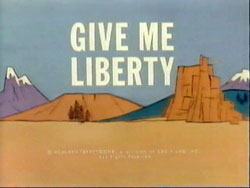 Honorable mention for Give Me Liberty (Terrytoos/Fox, James Hound, 8/67 – Ralph Bakshi/Cosmo Anzilotti, dir.) – By far, this seems the most formative and well-developed of the episodes of this, the last original Terrytoons series, and may possibly have been the pilot, considering its somewhat better animation than usual, and a less-over-the-top read for Hound that is in many ways more appealing that how the series eventually developed. Hound patrols in a private jet, checking in with his secretary “Miss Q” on a tie that serves as a telephone to see what the latest action may be. Miss Q’s first exciting announcement is that Hound’s laundry came back. Then she casually drops the news that the Statue of Liberty has been stolen. Hound breaks his usual straight-faced demeanor to crack an unexpected smile, and respond, “You’re putting me on.” Then, he returns to all-business, as he is informed, “You’re not putting me on.” It is a trap to lure Hound to his doom, set up by one Mr. Big and his assistants, an Igor type named Chop Chop, and a green monster chained to a wall for emergency relief. They have hidden the statue in the Grand Canton, and leave a booby-trapped record player at the pedestal where the statute formerly rested to give Hound a clue – which he will not be able to follow, as the device is set to explode “at the musical tone”. Fortunately, Hound is wearing his asbestos underwear, and, charred though he is he touches base with Miss Q again. She claims his voice sounds distorted. “Are you kidding? I’m distorted all over”, responds Hound.
Honorable mention for Give Me Liberty (Terrytoos/Fox, James Hound, 8/67 – Ralph Bakshi/Cosmo Anzilotti, dir.) – By far, this seems the most formative and well-developed of the episodes of this, the last original Terrytoons series, and may possibly have been the pilot, considering its somewhat better animation than usual, and a less-over-the-top read for Hound that is in many ways more appealing that how the series eventually developed. Hound patrols in a private jet, checking in with his secretary “Miss Q” on a tie that serves as a telephone to see what the latest action may be. Miss Q’s first exciting announcement is that Hound’s laundry came back. Then she casually drops the news that the Statue of Liberty has been stolen. Hound breaks his usual straight-faced demeanor to crack an unexpected smile, and respond, “You’re putting me on.” Then, he returns to all-business, as he is informed, “You’re not putting me on.” It is a trap to lure Hound to his doom, set up by one Mr. Big and his assistants, an Igor type named Chop Chop, and a green monster chained to a wall for emergency relief. They have hidden the statue in the Grand Canton, and leave a booby-trapped record player at the pedestal where the statute formerly rested to give Hound a clue – which he will not be able to follow, as the device is set to explode “at the musical tone”. Fortunately, Hound is wearing his asbestos underwear, and, charred though he is he touches base with Miss Q again. She claims his voice sounds distorted. “Are you kidding? I’m distorted all over”, responds Hound.
 Hound jets to the Grand Canyon, and soon finds a statue meeting the description he has been provided. “Unless that’s Sitting Bull standing up, that’s the old girl”, Hound remarks. Anti-aircraft fire suddenly surrounds the plane, and a hit on the wing sends the craft into a spinning barrel-rpll, the plane coming to a stop upside down. The cockpit falls off, and Hound falls out of the pilot’s seat. “Good thing I have on my hat parachute”, says Hound. He presses a button which pops a parachute out the top of his chapeau. However, while the parachute ropes are strong, the hat’s chin strap isn’t, and pops open, dropping Hound into the canyon. Hound makes a mental note to have Miss Q sew a new button on that strap when he returns home. Hound dodges bullets, averts a knife attack by diving into a crevice, then radios Q that he’s just about finished out here – as a land mine explodes under him. Hound completes the sentence: “And maybe everywhere.” As Mr. Big looks out from the crown of the statue to discern Hound’s whereabouts, Hound sneaks into the statue’s ear. Hound demonstrates his knowledge of karate and judo holds – only to get thrown around like a sack of wet laundry by the villain. He is flung skyward, crashing through the glass torch in the statue’s arm, but rides down one of the points of the statue’s crown, reentering through one of the observation windows and knocking Mr. Big through the side of the statue, back into the canyon lair where Big keeps the imprisoned green monster. Big unleashes the beast with command to attack. But the beast is fed up with confinement, and takes out his vengeance on Big instead. Pointing to Hound, the beast says, “Him I like – You I hate”, and gives Big a sound beating. Back in his plane, Hound flies back toward headquarters, with an envelope containing a signed confession he has received from Mr. Big. Miss Q attempts to communicate to him a warning on the tie phone, just as Hound opens the side of the envelope. An explosion blasts the plane apart, leaving only Hound and the cockpit, as Hound finally hears the warning: “Don’t open the envelope – It is a booby trap.”
Hound jets to the Grand Canyon, and soon finds a statue meeting the description he has been provided. “Unless that’s Sitting Bull standing up, that’s the old girl”, Hound remarks. Anti-aircraft fire suddenly surrounds the plane, and a hit on the wing sends the craft into a spinning barrel-rpll, the plane coming to a stop upside down. The cockpit falls off, and Hound falls out of the pilot’s seat. “Good thing I have on my hat parachute”, says Hound. He presses a button which pops a parachute out the top of his chapeau. However, while the parachute ropes are strong, the hat’s chin strap isn’t, and pops open, dropping Hound into the canyon. Hound makes a mental note to have Miss Q sew a new button on that strap when he returns home. Hound dodges bullets, averts a knife attack by diving into a crevice, then radios Q that he’s just about finished out here – as a land mine explodes under him. Hound completes the sentence: “And maybe everywhere.” As Mr. Big looks out from the crown of the statue to discern Hound’s whereabouts, Hound sneaks into the statue’s ear. Hound demonstrates his knowledge of karate and judo holds – only to get thrown around like a sack of wet laundry by the villain. He is flung skyward, crashing through the glass torch in the statue’s arm, but rides down one of the points of the statue’s crown, reentering through one of the observation windows and knocking Mr. Big through the side of the statue, back into the canyon lair where Big keeps the imprisoned green monster. Big unleashes the beast with command to attack. But the beast is fed up with confinement, and takes out his vengeance on Big instead. Pointing to Hound, the beast says, “Him I like – You I hate”, and gives Big a sound beating. Back in his plane, Hound flies back toward headquarters, with an envelope containing a signed confession he has received from Mr. Big. Miss Q attempts to communicate to him a warning on the tie phone, just as Hound opens the side of the envelope. An explosion blasts the plane apart, leaving only Hound and the cockpit, as Hound finally hears the warning: “Don’t open the envelope – It is a booby trap.”
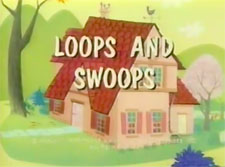 Loops and Swoops (Terrytoons/Fox, Sadcat, 11/68 -Art Bartsch, dir.). Sadcat was a strange little series, with two significantly-different setups. It was originally conceived by Ralph Bakshi as a “Fractured Fairy Tales” style takeoff, retelling the Cinderella tale in gender-bender fashion with a weakling spineless jellyfish of a cat pushed around by his two mean stepbrothers, Lattimore and Fenimore – and help, of sorts, available through Gadmouse, an Apprentice good fairy. Bakshi’s efforts often looked genuinely sad, with some of the cheapest, poorest animation to ever appear in a Terrytoon, and irregular pacing and timing, with only an occasional creative color design for layout backgrounds providing anything of note visually. When Bakshi left the studio, the task of keeping the faltering series going fell upon direct Art Bartsch. Bartsch decided upon several major changes. First, update the series to the present, rather than mire it in fairy tale days, to give it more current appeal and a broader spectrum of hah material. Second, improve the animation. The characters could now move in considerably more directions, rather than stand stock still and wiggle their eyebrows. Thirdly, Gadmouse had to go. But who would provide the help to a hopeless failure with no backbone or moxie? For this purpose, Bartsch introduced the character of a “Super Alter Ego” – a blue cat who can appear or disappear at will from out of Sadcat’s body, who is his exact opposite in character – bold, resourceful, never say die, and is determined to prove to Sadcat that he is inwardly a “tiger”. Alter Ego can not only magically appear whenever the chips are down, but possesses the power to enchant objects much in the manner of Gadmouse’s wand, to give Sadcat a secret “edge” in accomplishing his goals. The sudden change in format had to be jarring to theater audiences, if they had any familiarity with the earlier cartoons (which they probably didn’t_ – but it was a baby-step in the right direction. Scripts and timing began to improve – with limitations. First, a hook was needed for setting up plots – so, an unbreakable formula became the series model. Always set up the stepbrothers as fierce competitors in some sport or another, then bring out the Alter Ego to convince Sadcat that he should compete too – and on to victory. Bartsch may have figured if a sports series could work for Goofy, why not him? Thus, all manner of sports seem to have been exhausted by the films, to the point where one wonders if any possibilities remained for further scripts when the series ended, for lack of any other types of athletic competition. Arguably, a few might have been found by careful digging into the gamut of events of the Olympiad. But the options were slim, and the series thus reached a logical conclusion, getting lost while the getting was still good. The other limitation to the series’ growth was the positively rotten “Jazz” scores written for small combo by Jim Timmens, a musical director who seemed to thrive financially by composing pieces for the least number of instruments possible, which he had previously done in the waning days of Little Golden Records for Simon and Schuster. His scores do their best to undermine the impact and effect of whatever gags are thought up on the screen, such that some of these films might play better if viewed without a soundtrack at all, if you familiarize yourself with the dialogue on the first run.
Loops and Swoops (Terrytoons/Fox, Sadcat, 11/68 -Art Bartsch, dir.). Sadcat was a strange little series, with two significantly-different setups. It was originally conceived by Ralph Bakshi as a “Fractured Fairy Tales” style takeoff, retelling the Cinderella tale in gender-bender fashion with a weakling spineless jellyfish of a cat pushed around by his two mean stepbrothers, Lattimore and Fenimore – and help, of sorts, available through Gadmouse, an Apprentice good fairy. Bakshi’s efforts often looked genuinely sad, with some of the cheapest, poorest animation to ever appear in a Terrytoon, and irregular pacing and timing, with only an occasional creative color design for layout backgrounds providing anything of note visually. When Bakshi left the studio, the task of keeping the faltering series going fell upon direct Art Bartsch. Bartsch decided upon several major changes. First, update the series to the present, rather than mire it in fairy tale days, to give it more current appeal and a broader spectrum of hah material. Second, improve the animation. The characters could now move in considerably more directions, rather than stand stock still and wiggle their eyebrows. Thirdly, Gadmouse had to go. But who would provide the help to a hopeless failure with no backbone or moxie? For this purpose, Bartsch introduced the character of a “Super Alter Ego” – a blue cat who can appear or disappear at will from out of Sadcat’s body, who is his exact opposite in character – bold, resourceful, never say die, and is determined to prove to Sadcat that he is inwardly a “tiger”. Alter Ego can not only magically appear whenever the chips are down, but possesses the power to enchant objects much in the manner of Gadmouse’s wand, to give Sadcat a secret “edge” in accomplishing his goals. The sudden change in format had to be jarring to theater audiences, if they had any familiarity with the earlier cartoons (which they probably didn’t_ – but it was a baby-step in the right direction. Scripts and timing began to improve – with limitations. First, a hook was needed for setting up plots – so, an unbreakable formula became the series model. Always set up the stepbrothers as fierce competitors in some sport or another, then bring out the Alter Ego to convince Sadcat that he should compete too – and on to victory. Bartsch may have figured if a sports series could work for Goofy, why not him? Thus, all manner of sports seem to have been exhausted by the films, to the point where one wonders if any possibilities remained for further scripts when the series ended, for lack of any other types of athletic competition. Arguably, a few might have been found by careful digging into the gamut of events of the Olympiad. But the options were slim, and the series thus reached a logical conclusion, getting lost while the getting was still good. The other limitation to the series’ growth was the positively rotten “Jazz” scores written for small combo by Jim Timmens, a musical director who seemed to thrive financially by composing pieces for the least number of instruments possible, which he had previously done in the waning days of Little Golden Records for Simon and Schuster. His scores do their best to undermine the impact and effect of whatever gags are thought up on the screen, such that some of these films might play better if viewed without a soundtrack at all, if you familiarize yourself with the dialogue on the first run.
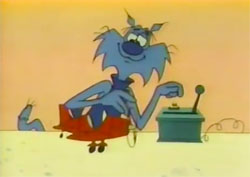 Today, Sadcat is constructing the “Sadcat Special” – a reasonably cool red model plane with working engine, that he believes he will enter into a race to take place that afternoon. How he can be so stupid as to hold this belief defies logic – as his brothers have been building real planes to compete for a gold cip in a genuine air race. Didn’t Sadcat ever notice the difference in size? So we’re off to a bad start plotwise – but things do get better. A few giggles ensue when Sadcat tries out his model plane inside the house, letting it loose into the brothers’ bedroom. The plane begins ripping through the blankets under which the brothers rest, leading the brothers to believe it is some kind of giant moth. When the plane breaks through the covers, one of the brothers painfully yells, “It bit me!” Eventually, the brothers get wise, and inform Sadcat of his bonehead error about the race, while respectively attempting to outboast each other about which one of them will ring home the cup. As the brother head off to the airfield. Alter Ego appears. Knowing he hasn’t even got a plane, Sadcat tries to dismiss him casually, stating “There’s nothing you can do for me today.” But Alter Ego is a s determined as ever that Sadcat (or as he calls him, Tiger) will enter the race and win – then, without a clue of an idea himself, asks Sadcat point blank, “How ya gonna do it?” Sadcat has no time to ad-lib a response, as his foot gets caught in the cockpit of his model plane, tripping him. “Of course. The model plane”, concludes Ego, giving the plane a zap of magic to rev up its engine to full power, while Sadcat just looks on in pure puzzlement.
Today, Sadcat is constructing the “Sadcat Special” – a reasonably cool red model plane with working engine, that he believes he will enter into a race to take place that afternoon. How he can be so stupid as to hold this belief defies logic – as his brothers have been building real planes to compete for a gold cip in a genuine air race. Didn’t Sadcat ever notice the difference in size? So we’re off to a bad start plotwise – but things do get better. A few giggles ensue when Sadcat tries out his model plane inside the house, letting it loose into the brothers’ bedroom. The plane begins ripping through the blankets under which the brothers rest, leading the brothers to believe it is some kind of giant moth. When the plane breaks through the covers, one of the brothers painfully yells, “It bit me!” Eventually, the brothers get wise, and inform Sadcat of his bonehead error about the race, while respectively attempting to outboast each other about which one of them will ring home the cup. As the brother head off to the airfield. Alter Ego appears. Knowing he hasn’t even got a plane, Sadcat tries to dismiss him casually, stating “There’s nothing you can do for me today.” But Alter Ego is a s determined as ever that Sadcat (or as he calls him, Tiger) will enter the race and win – then, without a clue of an idea himself, asks Sadcat point blank, “How ya gonna do it?” Sadcat has no time to ad-lib a response, as his foot gets caught in the cockpit of his model plane, tripping him. “Of course. The model plane”, concludes Ego, giving the plane a zap of magic to rev up its engine to full power, while Sadcat just looks on in pure puzzlement.
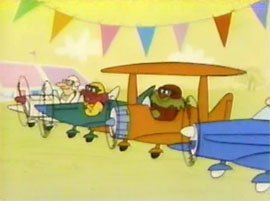 At the starting line at the airstrip, the flag is waived, and a dozen or so planes take off past the announcer’s platform, leaving him tangled up in microphone wire. A late entry suddenly flashes past – Sadcat, huddled into a seated position atop the fuselage of his model plane, bracing himself with a foot on each wing. “I’ll pretend I didn’t see that”, says the announcer. Sadcat drops into a position just ahead of the plane of one of his brothers. Shocked at seeing Sadcat in the race, the brother gives Sadcat’s plane a bump with the propeller. Sadcat goes into a spin, and falls off of his mount. However, the plane performs a powered looping dive, intercepting the falling cat, whose head becomes stuck upside down in the model plane’s cockpit. Lattimore and Fenimore are otherwise engaged in their own means of dirty-cheat competition against each other. Though all the entries are prop-driven, Fenimore opens a set of bomb-bay doors, and reveals a hidden het engine on an extender, which fires up to give him added thrust. “Hey, no jet engines allowed”, shouts Lattimore. Above him, Fenimore descends, to use the hey pod as a clobbering device to smash down repeatedly on the upper wing of Lattimore’s biplane, klunking his brother on the head. “Is that allowed?” laughs Fenimore. But Lattimore has the last laugh, reaching up and gabbing hold of the jet pod, then twisting it to point in the opposite direction. The het force now pushes Fenimore in reverse of his flight direction, and drags him backwards, while Lattimore waves him bye-bye. Back of the pack, Sadcat is still trying to get his bearings, finally prying his head out of the miniature cockpit. All he sees is Fenimore’s plane shooting backwards to meet him. CRASH!! Fenimore’s plane shoots on past the collision point, missing one important component – the secret jet motor. Now Sadcat finds himself sitting astride the broken-off jet pod instead of his model plane – and somehow turned in the right direction. He zooms forward, and soon is matching stride with Lattimore. “Look brother”, says Sadcat, “I’m a member of the jet set.” “Good for you. Have a ball”, responds Lattimore, producing a bowling ball. Flying under Sadcat’s pod, Lattimore slaps the bowling ball onto the air intake of the jet engine – stopping it cold. Sadcat and the pod fall helplessly, as Alter ego appears on the pod with him. “This is not the time to give up”, Ego insists. They both fall out of frame, and a loud crash is heard. Below, we find them and the wrecked pod in a heap, as Ego admits “This is the time to give up.” For once, however, Sadcat shows a spark of determination of his own. “Never. All we need is another plane”, he states with determination.
At the starting line at the airstrip, the flag is waived, and a dozen or so planes take off past the announcer’s platform, leaving him tangled up in microphone wire. A late entry suddenly flashes past – Sadcat, huddled into a seated position atop the fuselage of his model plane, bracing himself with a foot on each wing. “I’ll pretend I didn’t see that”, says the announcer. Sadcat drops into a position just ahead of the plane of one of his brothers. Shocked at seeing Sadcat in the race, the brother gives Sadcat’s plane a bump with the propeller. Sadcat goes into a spin, and falls off of his mount. However, the plane performs a powered looping dive, intercepting the falling cat, whose head becomes stuck upside down in the model plane’s cockpit. Lattimore and Fenimore are otherwise engaged in their own means of dirty-cheat competition against each other. Though all the entries are prop-driven, Fenimore opens a set of bomb-bay doors, and reveals a hidden het engine on an extender, which fires up to give him added thrust. “Hey, no jet engines allowed”, shouts Lattimore. Above him, Fenimore descends, to use the hey pod as a clobbering device to smash down repeatedly on the upper wing of Lattimore’s biplane, klunking his brother on the head. “Is that allowed?” laughs Fenimore. But Lattimore has the last laugh, reaching up and gabbing hold of the jet pod, then twisting it to point in the opposite direction. The het force now pushes Fenimore in reverse of his flight direction, and drags him backwards, while Lattimore waves him bye-bye. Back of the pack, Sadcat is still trying to get his bearings, finally prying his head out of the miniature cockpit. All he sees is Fenimore’s plane shooting backwards to meet him. CRASH!! Fenimore’s plane shoots on past the collision point, missing one important component – the secret jet motor. Now Sadcat finds himself sitting astride the broken-off jet pod instead of his model plane – and somehow turned in the right direction. He zooms forward, and soon is matching stride with Lattimore. “Look brother”, says Sadcat, “I’m a member of the jet set.” “Good for you. Have a ball”, responds Lattimore, producing a bowling ball. Flying under Sadcat’s pod, Lattimore slaps the bowling ball onto the air intake of the jet engine – stopping it cold. Sadcat and the pod fall helplessly, as Alter ego appears on the pod with him. “This is not the time to give up”, Ego insists. They both fall out of frame, and a loud crash is heard. Below, we find them and the wrecked pod in a heap, as Ego admits “This is the time to give up.” For once, however, Sadcat shows a spark of determination of his own. “Never. All we need is another plane”, he states with determination.
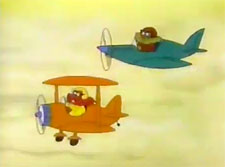 The scene fades in to a few moments later. Even Alter Egos have their limitations, as Sadcat’s admits. “This was the best I could do on short notice”, he states, as he sets Sadcat up on, of all things, an oversized paper airplane! With a push off a high ledge, Sadcat’s new craft is put in motion. Lattimore and Fenimore jockey for position, but Sadcat glides by right ver them. Will the brothers take this laying down? Not if this is a cartoon. They each stand atop their respective plane, armed with a pair each of large scissors. As Sadcat flattens himself atop his paper wings to duck for cover, the brother make a pass, their scissor blades snipping wildly. ‘We’re regular cut-ups”, Fenimore asides to the audience. When they are through, the remains of Sadcat’s plane fold out from under him, as a string of Sadcat paper dolls. Our hero falls again, conceding “Guess I’m really through this time.” “Not yet, tiger”, shouts Ego, appearing again beside him. Ego has spies a pizza palace far below, where a chef is busy tossing a freshly-made pizza unto the air. Ego gives the pizza a magical zap – and it begins to spin in the air, then spirals out to catch Sadcat and Ego aboard it, while the perplexed pizza maker wonders why his creation has never come down. Ego disappears so as not to steal the thunder from his protégé, while Sadcat soars past the brothers on his amazing mount, and first prize is awarded to an anchovy pizza. Sadcat receives the trophy in the winner’s circle, while the announcer asks if Sadcat will give everyone a chance to see his amazing flying saucer. “I can’t, I ate it”, says our hero, in his usual spineless way.
The scene fades in to a few moments later. Even Alter Egos have their limitations, as Sadcat’s admits. “This was the best I could do on short notice”, he states, as he sets Sadcat up on, of all things, an oversized paper airplane! With a push off a high ledge, Sadcat’s new craft is put in motion. Lattimore and Fenimore jockey for position, but Sadcat glides by right ver them. Will the brothers take this laying down? Not if this is a cartoon. They each stand atop their respective plane, armed with a pair each of large scissors. As Sadcat flattens himself atop his paper wings to duck for cover, the brother make a pass, their scissor blades snipping wildly. ‘We’re regular cut-ups”, Fenimore asides to the audience. When they are through, the remains of Sadcat’s plane fold out from under him, as a string of Sadcat paper dolls. Our hero falls again, conceding “Guess I’m really through this time.” “Not yet, tiger”, shouts Ego, appearing again beside him. Ego has spies a pizza palace far below, where a chef is busy tossing a freshly-made pizza unto the air. Ego gives the pizza a magical zap – and it begins to spin in the air, then spirals out to catch Sadcat and Ego aboard it, while the perplexed pizza maker wonders why his creation has never come down. Ego disappears so as not to steal the thunder from his protégé, while Sadcat soars past the brothers on his amazing mount, and first prize is awarded to an anchovy pizza. Sadcat receives the trophy in the winner’s circle, while the announcer asks if Sadcat will give everyone a chance to see his amazing flying saucer. “I can’t, I ate it”, says our hero, in his usual spineless way.
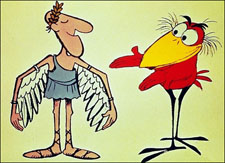 And then there’s a brief sequence in the Academy Award winning It’s Tough to Be a Bird – (Disney, 12/10/69 – Ward Kimball, dir.). This not-so-short short gives the impression off the bat of being a project intended for the “Wonderful World of Color” that got sidetracked to the big screen. Particularly, the fact that much live-action footage is interspersed between the animated vignettes follows the standard pattern for production of Disney TV product. It runs a little short on footage for an hour-long TV show – but it was not long until an “expanded” version appeared over the airwaves, with additional wraparound animation that gives every appearance of having been created at the same time as the rest of the production – so what we’re probably seeing in the theatrical version is an edited-down print of the already completed TV version that was to be. The move proved lucrative – as the “short” would win Disney an Oscar, in a not-overly-competitive market.
And then there’s a brief sequence in the Academy Award winning It’s Tough to Be a Bird – (Disney, 12/10/69 – Ward Kimball, dir.). This not-so-short short gives the impression off the bat of being a project intended for the “Wonderful World of Color” that got sidetracked to the big screen. Particularly, the fact that much live-action footage is interspersed between the animated vignettes follows the standard pattern for production of Disney TV product. It runs a little short on footage for an hour-long TV show – but it was not long until an “expanded” version appeared over the airwaves, with additional wraparound animation that gives every appearance of having been created at the same time as the rest of the production – so what we’re probably seeing in the theatrical version is an edited-down print of the already completed TV version that was to be. The move proved lucrative – as the “short” would win Disney an Oscar, in a not-overly-competitive market.
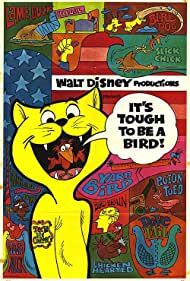 The film loosely follows the misadventures of a representative member of a generic species of bird, who talks much in the manner of Peter Falk, and classifies all birds as “born losers” due to mankind’s envy of their unmatchable powers of flight, and taking out of their frustrations upon his kind by pestering and hunting them to extinction or near-extinction. The bird is repeatedly seen after encounters with man and his bullets, slingshots, or other weapons, bandaged and in traction. He talk-sings a 30’s style ballad about his plight as a title song, “to set the record straight” as he plays it on a gramophone. He recounts failed flying attempts of man, such as Icarus and Michelangelo, and uses in history of birds and bird emblems in ancient Rome, royal falconry, navigation, etc. A famous live-action montage of failed experimental airplane flights is followed by a brief sequence of the bird navigating an airplane through a World War, as his plane is systematically blasted apart by anti-aircraft fire, leaving him alone to circle and fall in flames. The final shot is perhaps the most off-the-wall image of the reel, as the bird finally has to concede that mankind has figured out how to fly – when an image of Mary Poppins soars over his head, using her umbrella. (Also, watch for a shot of Kimball himself in the live-action sequences, posing as a bird-watcher recording the sounds of the avians with a tape recorder. It any other staff faces are recognizable to you, please feel free to provide a roll-call.)
The film loosely follows the misadventures of a representative member of a generic species of bird, who talks much in the manner of Peter Falk, and classifies all birds as “born losers” due to mankind’s envy of their unmatchable powers of flight, and taking out of their frustrations upon his kind by pestering and hunting them to extinction or near-extinction. The bird is repeatedly seen after encounters with man and his bullets, slingshots, or other weapons, bandaged and in traction. He talk-sings a 30’s style ballad about his plight as a title song, “to set the record straight” as he plays it on a gramophone. He recounts failed flying attempts of man, such as Icarus and Michelangelo, and uses in history of birds and bird emblems in ancient Rome, royal falconry, navigation, etc. A famous live-action montage of failed experimental airplane flights is followed by a brief sequence of the bird navigating an airplane through a World War, as his plane is systematically blasted apart by anti-aircraft fire, leaving him alone to circle and fall in flames. The final shot is perhaps the most off-the-wall image of the reel, as the bird finally has to concede that mankind has figured out how to fly – when an image of Mary Poppins soars over his head, using her umbrella. (Also, watch for a shot of Kimball himself in the live-action sequences, posing as a bird-watcher recording the sounds of the avians with a tape recorder. It any other staff faces are recognizable to you, please feel free to provide a roll-call.)
Next time, we’ll begin a short delve into selected aviation in the medium of the television cartoon.

